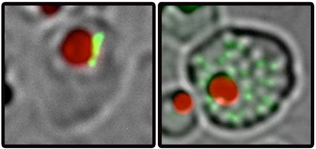5-ALA and Iron in Synergistically Inhibiting Growth of Plasmodium Falciparum Malaria Parasites
Published: December 6, 2013
The University of Tokyo, a national university (main campus: Bunkyo-ku, Tokyo; President: Junichi Hamada), Tokyo Institute of Technology, a national university (main campus: Meguro-ku, Tokyo; President: Yoshinao Mishima),MRC National Institute for Medical Research (London, U.K. Director: Jim Smith), and SBI Pharmaceuticals Co., Ltd. (head office: Minato-ku, Tokyo; Representative Director and CEO: Yoshitaka Kitao; “SBI Pharmaceuticals”), presented their findings in The Journal of Biochemistry (2 December 2013) regarding the working mechanism of 5-aminolevulinic acid (5-ALA) and bivalent iron in inhibiting the growth of Plasmodium falciparum (P. falciparum) malaria parasites.
Key Points of the Findings
- The findings revealed a crucial element of the mechanism of inhibiting the growth of P. falciparum through a combination of 5-ALA and bivalent iron.
- The findings are expected to lead to the development of new medical products to treat malaria, a disease that affects a large number of people around the world.
Outline of Announcement
Malaria is one of the world's three major infectious diseases and it reportedly infects hundreds of millions of people and kills over 1 million people each year. It has been known that the administration of 5-ALA accumulates porphyrins in cells that are infected with P. falciparum and the accumulated porphyrins can be used as a guide to spot and kill P. falciparum by irradiating light on them. However, irradiating light on the blood is unrealistic and thus has remained a major deterrent to commercialization of 5-ALA. The development of 5-ALA-based agents that do not require the irradiation of light has been long awaited.
Mr. Kiyoshi Kita (Professor, The University of Tokyo, Graduate School of Medicine), Mr. Shun-Ichiro Ogura (Associate Professor, Tokyo Institute of Technology, Graduate School of Bioscience and Biotechnology), and SBI Pharmaceuticals presented the results of the study at an academic conference in 2011. The results showed that the concomitant administration of 5-ALA and bivalent iron can inhibit the growth of P. falciparum without the need to irradiate light. Subsequently, MRC National Institute for Medical Research has joined to further research. An analysis of porphyrins in each organelle of P. falciparum uncovered a crucial element of the working mechanism, where the combined use of 5-ALA and bivalent iron causes an accumulation of porphyrins in certain organelles and generates active oxygen which in turn inhibits the growth of P. falciparum.
These findings are expected to lead to the development of new medical products to treat malaria, a disease that affects a large number of people around the world. The safety of 5-ALA and bivalent iron has already been established and both 5-ALA and bivalent iron have been used for food products and medical purposes. In addition, clinical development is expected to take place shortly. With fewer side effects compared to any of the existing antimalarial drugs, 5-ALA and bivalent iron are expected to be revolutionary antimalarial drugs that can be administered for prophylactic purposes.

. Any information published on this site will be valid in relation to Science Tokyo.



